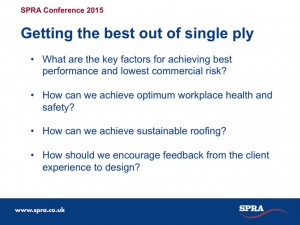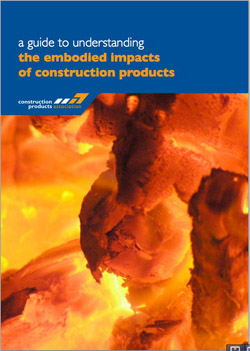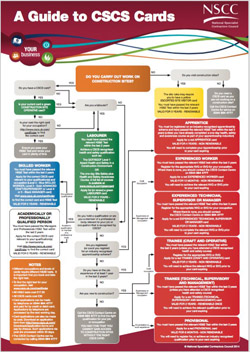SPRA National Conference 2015 – Review
Last week saw the first national conference of the Single Ply Roofing Association, which had the objective of providing guidance and insights to its members from across the industry. In this post we look at what the conference covered and what was learned, and share some links to other useful information.
The Single Ply Roofing Association (SPRA) membership covers the whole supply chain from manufacturers and distributors to specialist contractors. Members are independently audited annually against rigorous quality criteria from manufacture to project completion.
As well as supporting its members, SPRA provides considerable support to specifiers including technical advice, referrals, site inspections and best practice workshops. SPRA is also the sole authority on polymeric single ply roofing membranes recognised by the National Federation of Roofing Contractors (NFRC).
Pre-start consultation – connecting the supply chain

The first session, introduced by CEO James Talman set the tone of the conference. Talman wanted to event to stimulate debate provide genuine opportunities for discussion and interaction with the audience, and he wasn’t disappointed. You can read his thoughts at the end of this post.
After a set of challenging questions from Technical Director Jim Hooker and a impassioned plea for early involvement of the supply chain from Gary Wilburn of HPW Architecture, there followed a highly interactive panel discussion where Gary and Jim were joined by Clive Johnson of major client Land Securities and Mark Graham of major contractor Balfour Beatty.
The discussion picked out some of the challenges to developing the necessary trust that successful projects require: insufficient learning of lessons and sharing knowledge, pressure to recommend inappropriate products, and a lack of focus on the health of the workforce and building users.
Whilst Wilburn urged the specialist roofing contractors and manufacturers in the audience to engage earlier with designers, members from the floor and the audience on twitter pointed out that their normal experience was often contrary to this.
Clearly there is a need to improve communication within the supply chain, but this is already happening in places. During the panel session Clive Johnson confirmed that Land Securities have adopted the SPRA standards and requirements and consequently will only use SPRA members on their projects. He also challenged the roofing industry to insure it adopted the Breathe Freely Worker Health Protection for Construction.
Greening the Industry and recycling PVC
Session two brought us a challenging look ahead by Jane Thornback of the Construction Products Association and a case study on PVC recycling by Jane Gardner of Axion.
 Thornback’s look into the future included a call for a performance, not specification driven industry, and a demand for long-term consistency in policy so as to encourage investment. She touched on the digitisation of the population and expressed a surprising concern for the growth of the Internet of Things. She also pointed out to contractors that an Environmental Product Declaration is not a certificate of worthiness but a statement of product features; what matters are the values themselves.
Thornback’s look into the future included a call for a performance, not specification driven industry, and a demand for long-term consistency in policy so as to encourage investment. She touched on the digitisation of the population and expressed a surprising concern for the growth of the Internet of Things. She also pointed out to contractors that an Environmental Product Declaration is not a certificate of worthiness but a statement of product features; what matters are the values themselves.
Tools are available to help product companies look at sustainability, said Thornback, and recommended starting with the CPA Guide to Understanding the Embodied Impacts of Construction Products. The CPA is also about to launch a new report on how construction product companies are using water.
Thornback also pointed out the siloed nature of many product and contracting companies. A product company’s technical department needs to train up its marketing people, she said, and the sustainability specialists in contractors need to train up their procurement people, in order to reap the benefits of joined-up thinking about sustainability.
Our second speaker Jane Gardner of Axion Consulting outlined the Recovinyl PVC Recycling Scheme and the RecoFloor PVC flooring recycling scheme, the latter of which which has collected 758,000m2 of PVC flooring for recycling since 2009. The scheme saves up to 70% on the cost of landfill, and there is a significant benefit for contractors who participate. How could such a recycling scheme be used for PVC roofing materials, and how could other roofing product manufacturers learn from the experience of Recofloor?
R&D Funding, CompetentRoofer, CSCS cards
After a short break members were given the option of learning more about the Horizon 2020 European R&D funding scheme or the CompetentRoofer programme.
Dr Jane Watkins of Innovate UK, the national contact point for SMEs, pointed out that although the Horizon 2020 programme has over €7.2bn to spend on market research and innovation before 2020, few in the audience have considered accessing European funding. In order to encourage SME applications the topics for which funding is available are very broad. Watkins encouraged members to get in touch with her and discuss the opportunities.
 Kevin Taylor of BRC Industrial Roofing (Midlands) Ltd and Sarah Wicks of NSCC introduced CompetentRoofer, the government licensed competent person scheme that allows professional roofing contractors to self-certify that their roof refurbishment work complies with Building Regulations in England and Wales. This saves property owners time and money and provides reassurance that the Building Regulations are being complied with. The scheme also offers an insurance backed warrantee of up to £50k; the vast majority of SPRA and NFRC roofers are members.
Kevin Taylor of BRC Industrial Roofing (Midlands) Ltd and Sarah Wicks of NSCC introduced CompetentRoofer, the government licensed competent person scheme that allows professional roofing contractors to self-certify that their roof refurbishment work complies with Building Regulations in England and Wales. This saves property owners time and money and provides reassurance that the Building Regulations are being complied with. The scheme also offers an insurance backed warrantee of up to £50k; the vast majority of SPRA and NFRC roofers are members.
The conference reassembled for a discussion of the Construction Skills Certification Scheme (CSCS) and the importance of upskilling the roofing industry. CSCS cards provide proof that individuals working on construction sites have the required training and qualifications, and the scheme is undergoing some changes. Over 1.4 million cards can now be checked electronically, reducing fraud. The kinds of cards being produced is also changing, details of which are available in a recorded webinar. There is also a useful guide to CSCS cards available as an infographic pdf.
BIM brings it all together
 Throughout the conference the topics of information, collaboration and digitisation kept returning, so it was fitting that the final conference session addressed the future of construction, in particular the dramatic changes that BIM is having on how buildings are designed, procured and operated.
Throughout the conference the topics of information, collaboration and digitisation kept returning, so it was fitting that the final conference session addressed the future of construction, in particular the dramatic changes that BIM is having on how buildings are designed, procured and operated.
Casey Rutland of Arup Associates kicked off the session with a serious yet humorous look at excuses for not implementing BIM and dispelled some myths; not least that BIM is expensive, irrelevant to manufacturers and takes too much time.
Rutland pointed out that BIM is changing the way that projects are procured and products are specified, allowing collaboration to take place throughout the supply chain, cutting waste and saving money. He pointed out that the ‘I’ in BIM stands for information and that structured data is where the true value is, the value that designers are looking for. Rutland argued that using third party services to build objects was at best a short-term measure when the real benefits will come through implementing BIM within our organisations.
Chris Vickers of the NBS demonstrated the use of SPRA generic BIM objects within a model using Revit software, showing how a designer can outline the design and then switch to specific products relatively easily at the detailed stage. The demonstration was hugely impressive and helped the audience get a grasp of the benefits within what is to them a very new subject. Only one audience member said they were implementing BIM in house.
Rutland recommended that manufacturers get in touch with the BIM for Manufacturers (BIM4M2) group for independent advice. The group is holding a seminar for manufacturers on 28 July in London called ‘Help with the Journey’. He also recommended that manufacturers learn about product data templates as well as objects, a topic to be covered in the July event.
In Conclusion
Speaking after the event, James Talman, CEO of The Single Ply Roofing Association commented:
“We are delighted at the response to this Conference and are pleased that the format of inviting stakeholders and other potential influencers to lead the discussions was so well received. An open dialogue is vital to the future growth of our industry. We have listened and will act on the measures that will continue to help our sector grow.”
To follow the discussions and a commentary of the conference visit our live blog here.
To find out more about SPRA visit their website here.














[…] live blogged the SPRA Single Ply Roofing Association Conference in July, and the Cradle to Cradle debate at the RIBA, and ran another clutch of in-house training […]